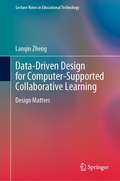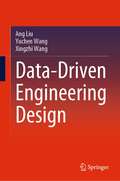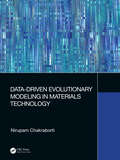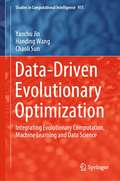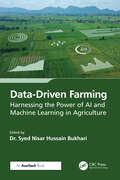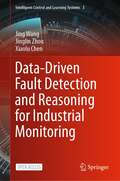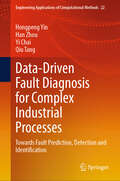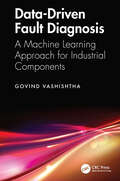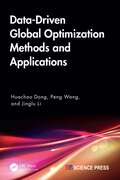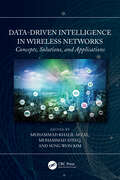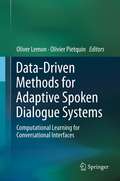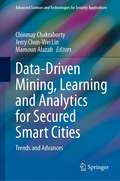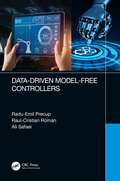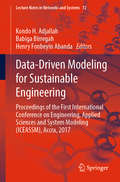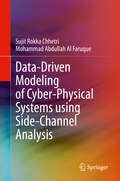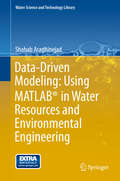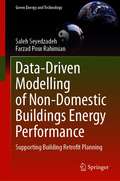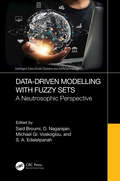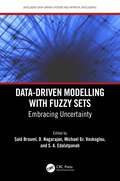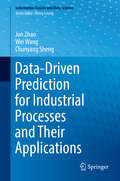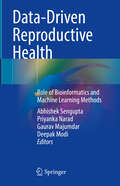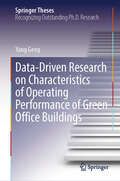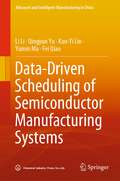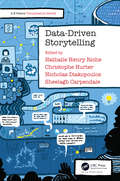- Table View
- List View
Data-Driven Design for Computer-Supported Collaborative Learning: Design Matters (Lecture Notes in Educational Technology)
by Lanqin ZhengThis book highlights the importance of design in computer-supported collaborative learning (CSCL) by proposing data-driven design and assessment. It addresses data-driven design, which focuses on the processing of data and on improving design quality based on analysis results, in three main sections. The first section explains how to design collaborative learning activities based on data-driven design approaches, while the second shares illustrative examples of computer-supported collaborative learning activities. In turn, the third and last section demonstrates how to evaluate design quality and the fidelity of enactment based on design-centered research.The book features several examples of innovative data-driven design approaches to optimizing collaborative learning activities; highlights innovative CSCL activities in authentic learning environments; demonstrates how learning analytics can be used to optimize CSCL design; and discusses the design-centered research approach to evaluating the alignment between design and enactment in CSCL. Given its scope, it will be of interest to a broad readership including researchers, educators, practitioners, and students in the field of collaborative learning, as well as the rapidly growing community of people who are interested in optimizing learning performance with CSCL.
Data-Driven Engineering Design
by Yuchen Wang Ang Liu Xingzhi WangThis book addresses the emerging paradigm of data-driven engineering design. In the big-data era, data is becoming a strategic asset for global manufacturers. This book shows how the power of data can be leveraged to drive the engineering design process, in particular, the early-stage design.Based on novel combinations of standing design methodology and the emerging data science, the book presents a collection of theoretically sound and practically viable design frameworks, which are intended to address a variety of critical design activities including conceptual design, complexity management, smart customization, smart product design, product service integration, and so forth. In addition, it includes a number of detailed case studies to showcase the application of data-driven engineering design. The book concludes with a set of promising research questions that warrant further investigation.Given its scope, the book will appeal to a broad readership, including postgraduate students, researchers, lecturers, and practitioners in the field of engineering design.
Data-Driven Evolutionary Modeling in Materials Technology
by Nirupam ChakrabortiDue to efficacy and optimization potential of genetic and evolutionary algorithms, they are used in learning and modeling especially with the advent of big data related problems. This book presents the algorithms and strategies specifically associated with pertinent issues in materials science domain. It discusses the procedures for evolutionary multi-objective optimization of objective functions created through these procedures and introduces available codes. Recent applications ranging from primary metal production to materials design are covered. It also describes hybrid modeling strategy, and other common modeling and simulation strategies like molecular dynamics, cellular automata etc. Features: Focuses on data-driven evolutionary modeling and optimization, including evolutionary deep learning. Include details on both algorithms and their applications in materials science and technology. Discusses hybrid data-driven modeling that couples evolutionary algorithms with generic computing strategies. Thoroughly discusses applications of pertinent strategies in metallurgy and materials. Provides overview of the major single and multi-objective evolutionary algorithms. This book aims at Researchers, Professionals, and Graduate students in Materials Science, Data-Driven Engineering, Metallurgical Engineering, Computational Materials Science, Structural Materials, and Functional Materials.
Data-Driven Evolutionary Optimization: Integrating Evolutionary Computation, Machine Learning and Data Science (Studies in Computational Intelligence #975)
by Yaochu Jin Handing Wang Chaoli SunIntended for researchers and practitioners alike, this book covers carefully selected yet broad topics in optimization, machine learning, and metaheuristics. Written by world-leading academic researchers who are extremely experienced in industrial applications, this self-contained book is the first of its kind that provides comprehensive background knowledge, particularly practical guidelines, and state-of-the-art techniques. New algorithms are carefully explained, further elaborated with pseudocode or flowcharts, and full working source code is made freely available. This is followed by a presentation of a variety of data-driven single- and multi-objective optimization algorithms that seamlessly integrate modern machine learning such as deep learning and transfer learning with evolutionary and swarm optimization algorithms. Applications of data-driven optimization ranging from aerodynamic design, optimization of industrial processes, to deep neural architecture search are included.
Data-Driven Farming: Harnessing the Power of AI and Machine Learning in Agriculture
by Syed Nisar Hussain BukhariIn the dynamic realm of agriculture, artificial intelligence (AI) and machine learning (ML) emerge as catalysts for unprecedented transformation and growth. The emergence of big data, Internet of Things (IoT) sensors, and advanced analytics has opened up new possibilities for farmers to collect and analyze data in real-time, make informed decisions, and increase efficiency. AI and ML are key enablers of data-driven farming, allowing farmers to use algorithms and predictive models to gain insights into crop health, soil quality, weather patterns, and more. Agriculture is an industry that is deeply rooted in tradition, but the landscape is rapidly changing with the emergence of new technologies.Data-Driven Farming: Harnessing the Power of AI and Machine Learning in Agriculture is a comprehensive guide that explores how the latest advances in technology can help farmers make better decisions and maximize yields. It offers a detailed overview of the intersection of data, AI, and ML in agriculture and offers real-world examples and case studies that demonstrate how these tools can help farmers improve efficiency, reduce waste, and increase profitability. Exploring how AI and ML can be used to achieve sustainable and profitable farming practices, the book provides an introduction to the basics of data-driven farming, including an overview of the key concepts, tools, and technologies. It also discusses the challenges and opportunities facing farmers in today’s data-driven landscape. Covering such topics as crop monitoring, weather forecasting, pest management, and soil health management, the book focuses on analyzing data, predicting outcomes, and optimizing decision-making in a range of agricultural contexts.
Data-Driven Fault Detection and Reasoning for Industrial Monitoring (Intelligent Control and Learning Systems #3)
by Jing Wang Jinglin Zhou Xiaolu ChenThis open access book assesses the potential of data-driven methods in industrial process monitoring engineering. The process modeling, fault detection, classification, isolation, and reasoning are studied in detail. These methods can be used to improve the safety and reliability of industrial processes. Fault diagnosis, including fault detection and reasoning, has attracted engineers and scientists from various fields such as control, machinery, mathematics, and automation engineering. Combining the diagnosis algorithms and application cases, this book establishes a basic framework for this topic and implements various statistical analysis methods for process monitoring. This book is intended for senior undergraduate and graduate students who are interested in fault diagnosis technology, researchers investigating automation and industrial security, professional practitioners and engineers working on engineering modeling and data processing applications. This is an open access book.
Data-Driven Fault Diagnosis for Complex Industrial Processes: Towards Fault Prediction, Detection and Identification (Engineering Applications of Computational Methods #22)
by Yi Chai Han Zhou Hongpeng Yin Qiu TangThis book summarizes techniques of fault prediction, detection, and identification, all included specifically in the data-driven fault diagnosis requirements within industrial processes, drawing from the combination of data science, machine learning, and domain-specific expertise. In the modern industrial processes, where efficiency, productivity, and safety stand as paramount pillars, the pursuit of fault diagnosis has become more crucial than ever. The widespread use of computer systems, along with new sensor hardware, generates significant quantities of real-time process data. It has been frequently asked what could be done with both the real-time and archived historical data, to not only promising efficiency but providing prospect of a brighter, more resilient future. This book starts with the definition, related work, and open test-bed for industrial process fault diagnosis. Then, it presents several data-driven methods on fault prediction, fault detection, and fault diagnosis, with consideration of properties of industrial processes, such as varying operation modes, non-Gaussian, nonlinearity. It distills cutting-edge methodologies and insights which may inspire for industrial practitioners, researchers, and academicians alike.
Data-Driven Fault Diagnosis: A Machine Learning Approach for Industrial Components
by Govind VashishthaData-Driven Fault Diagnosis delves into the application of machine learning techniques for achieving robust and efficient fault diagnosis in industrial components.The book covers a range of key topics, including data acquisition and preprocessing, feature engineering, model selection and training, and real-time implementation of diagnostic systems. It examines popular machine learning algorithms like Support Vector Machines, Convolutional Neural Network, and Extreme Learning Machine, highlighting their strengths and limitations in different industrial contexts. Practical case studies and real-world examples from various sectors like manufacturing, energy, and transportation illustrate the real-world impact of these techniques.The aim of this book is to empower engineers, data scientists, and researchers with the knowledge and tools necessary to implement data-driven fault diagnosis systems in their respective industrial domains.
Data-Driven Global Optimization Methods and Applications
by Peng Wang Huachao Dong Jinglu LiThis book presents recent advances in data-driven global optimization methods, combining theoretical foundations with real-world applications to address complex engineering optimization challenges.The book begins with an overview of the state of the art, key technologies and standard benchmark problems in the field. It then delves into several innovative approaches: space reduction-based, hybrid surrogate model-based and multi-surrogate model-based global optimization, followed by surrogate-assisted constrained global optimization, discrete global optimization and high-dimensional global optimization. These methods represent a variety of optimization techniques that excel in both optimization capability and efficiency, making them ideal choices for complex engineering optimization problems. Through benchmark test problems and real-world engineering applications, the book illustrates the practical implementation of these methods, linking established theories with cutting-edge research in industrial and engineering optimization.Both a professional book and an academic reference, this title will provide valuable insights for researchers, students, engineers and practitioners in a variety of fields, including optimization methods and algorithms, engineering design and manufacturing and artificial intelligence and machine learning.
Data-Driven Innovation for Intelligent Technology: Perspectives and Applications in ICT (Studies in Big Data #148)
by Jorge Brieva Lourdes Martínez-Villaseñor Hiram Ponce Ernesto Moya-Albor Octavio Lozada-FloresThis book focuses on new perspectives and applications of data-driven innovation technologies, applied artificial intelligence, applied machine learning and deep learning, data science, and topics related to transforming data into value.It includes theory and use cases to help readers understand the basics of data-driven innovation and to highlight the applicability of the technologies. It emphasizes how the data lifecycle is applied in current technologies in different business domains and industries, such as advanced materials, healthcare and medicine, resource optimization, control and automation, among others.This book is useful for anyone interested in data-driven innovation for smart technologies, as well as those curious in implementing cutting-edge technologies to solve impactful artificial intelligence, data science, and related information technology and communication problems.
Data-Driven Intelligence in Wireless Networks: Concepts, Solutions, and Applications
by Sung Won Kim Muhammad Khalil Afzal Muhammad AteeqThis book highlights the importance of data-driven techniques to solve wireless communication problems. It presents a number of problems (e.g., related to performance, security, and social networking), and provides solutions using various data-driven techniques, including machine learning, deep learning, federated learning, and artificial intelligence.This book details wireless communication problems that can be solved by data-driven solutions. It presents a generalized approach toward solving problems using specific data-driven techniques. The book also develops a taxonomy of problems according to the type of solution presented and includes several case studies that examine data-driven solutions for issues such as quality of service (QoS) in heterogeneous wireless networks, 5G/6G networks, and security in wireless networks. The target audience of this book includes professionals, researchers, professors, and students working in the field of networking, communications, machine learning, and related fields.
Data-Driven Methods for Adaptive Spoken Dialogue Systems: Computational Learning for Conversational Interfaces
by Oliver Lemon Olivier PietquinData driven methods have long been used in Automatic Speech Recognition (ASR) and Text-To-Speech (TTS) synthesis and have more recently been introduced for dialogue management, spoken language understanding, and Natural Language Generation. Machine learning is now present "end-to-end" in Spoken Dialogue Systems (SDS). However, these techniques require data collection and annotation campaigns, which can be time-consuming and expensive, as well as dataset expansion by simulation. In this book, we provide an overview of the current state of the field and of recent advances, with a specific focus on adaptivity.
Data-Driven Mining, Learning and Analytics for Secured Smart Cities: Trends and Advances (Advanced Sciences and Technologies for Security Applications)
by Jerry Chun-Wei Lin Mamoun Alazab Chinmay ChakrabortyThis book provides information on data-driven infrastructure design, analytical approaches, and technological solutions with case studies for smart cities. This book aims to attract works on multidisciplinary research spanning across the computer science and engineering, environmental studies, services, urban planning and development, social sciences and industrial engineering on technologies, case studies, novel approaches, and visionary ideas related to data-driven innovative solutions and big data-powered applications to cope with the real world challenges for building smart cities.
Data-Driven Model-Free Controllers
by Radu-Emil Precup Raul-Cristian Roman Ali SafaeiThis book categorizes the wide area of data-driven model-free controllers, reveals the exact benefits of such controllers, gives the in-depth theory and mathematical proofs behind them, and finally discusses their applications. Each chapter includes a section for presenting the theory and mathematical definitions of one of the above mentioned algorithms. The second section of each chapter is dedicated to the examples and applications of the corresponding control algorithms in practical engineering problems. This book proposes to avoid complex mathematical equations, being generic as it includes several types of data-driven model-free controllers, such as Iterative Feedback Tuning controllers, Model-Free Controllers (intelligent PID controllers), Model-Free Adaptive Controllers, model-free sliding mode controllers, hybrid model‐free and model‐free adaptive‐Virtual Reference Feedback Tuning controllers, hybrid model-free and model-free adaptive fuzzy controllers and cooperative model-free controllers. The book includes the topic of optimal model-free controllers, as well. The optimal tuning of model-free controllers is treated in the chapters that deal with Iterative Feedback Tuning and Virtual Reference Feedback Tuning. Moreover, the extension of some model-free control algorithms to the consensus and formation-tracking problem of multi-agent dynamic systems is provided. This book can be considered as a textbook for undergraduate and postgraduate students, as well as a professional reference for industrial and academic researchers, attracting the readers from both industry and academia.
Data-Driven Modeling for Sustainable Engineering: Proceedings of the First International Conference on Engineering, Applied Sciences and System Modeling (ICEASSM), Accra, 2017 (Lecture Notes in Networks and Systems #72)
by Kondo H. Adjallah Babiga Birregah Henry Fonbeyin AbandaThis book gathers the proceedings of the 1st International Conference on Engineering, Applied Sciences and System Modeling (ICEASSM), a four-day event (18th–21st April 2017) held in Accra, Ghana. It focuses on research work promoting a better understanding of engineering problems through applied sciences and modeling, and on solutions generated in an African setting but with relevance to the world as a whole. The book provides a holistic overview of challenges facing Africa, and addresses various areas from research and development perspectives. Presenting contributions by scientists, engineers and experts hailing from a host of international institutions, the book offers original approaches and technological solutions to help solve real-world problems through research and knowledge sharing. Further, it explores promising opportunities for collaborative research on issues of scientific, economic and social development, making it of interest to researchers, scientists and practitioners looking to conduct research in disciplines such as water supply, control, civil engineering, statistical modeling, renewable energy and sustainable urban development.
Data-Driven Modeling of Cyber-Physical Systems using Side-Channel Analysis
by Mohammad Abdullah Al Faruque Sujit Rokka ChhetriThis book provides a new perspective on modeling cyber-physical systems (CPS), using a data-driven approach. The authors cover the use of state-of-the-art machine learning and artificial intelligence algorithms for modeling various aspect of the CPS. This book provides insight on how a data-driven modeling approach can be utilized to take advantage of the relation between the cyber and the physical domain of the CPS to aid the first-principle approach in capturing the stochastic phenomena affecting the CPS. The authors provide practical use cases of the data-driven modeling approach for securing the CPS, presenting novel attack models, building and maintaining the digital twin of the physical system. The book also presents novel, data-driven algorithms to handle non- Euclidean data. In summary, this book presents a novel perspective for modeling the CPS.
Data-Driven Modeling: Using MATLAB® in Water Resources and Environmental Engineering (Water Science and Technology Library #67)
by Shahab Araghinejad"Data-Driven Modeling: Using MATLAB® in Water Resources and Environmental Engineering" provides a systematic account of major concepts and methodologies for data-driven models and presents a unified framework that makes the subject more accessible to and applicable for researchers and practitioners. It integrates important theories and applications of data-driven models and uses them to deal with a wide range of problems in the field of water resources and environmental engineering such as hydrological forecasting, flood analysis, water quality monitoring, regionalizing climatic data, and general function approximation. The book presents the statistical-based models including basic statistical analysis, nonparametric and logistic regression methods, time series analysis and modeling, and support vector machines. It also deals with the analysis and modeling based on artificial intelligence techniques including static and dynamic neural networks, statistical neural networks, fuzzy inference systems, and fuzzy regression. The book also discusses hybrid models as well as multi-model data fusion to wrap up the covered models and techniques. The source files of relatively simple and advanced programs demonstrating how to use the models are presented together with practical advice on how to best apply them. The programs, which have been developed using the MATLAB® unified platform, can be found on extras. springer. com. The main audience of this book includes graduate students in water resources engineering, environmental engineering, agricultural engineering, and natural resources engineering. This book may be adapted for use as a senior undergraduate and graduate textbook by focusing on selected topics. Alternatively, it may also be used as a valuable resource book for practicing engineers, consulting engineers, scientists and others involved in water resources and environmental engineering.
Data-Driven Modelling of Non-Domestic Buildings Energy Performance: Supporting Building Retrofit Planning (Green Energy and Technology)
by Saleh Seyedzadeh Farzad Pour RahimianThis book outlines the data-driven modelling of building energy performance to support retrofit decision-making. It explains how to determine the appropriate machine learning (ML) model, explores the selection and expansion of a reasonable dataset and discusses the extraction of relevant features and maximisation of model accuracy. This book develops a framework for the quick selection of a ML model based on the data and application. It also proposes a method for optimising ML models for forecasting buildings energy loads by employing multi-objective optimisation with evolutionary algorithms. The book then develops an energy performance prediction model for non-domestic buildings using ML techniques, as well as utilising a case study to lay out the process of model development. Finally, the book outlines a framework to choose suitable artificial intelligence methods for modelling building energy performances. This book is of use to both academics and practising energy engineers, as it provides theoretical and practical advice relating to data-driven modelling for energy retrofitting of non-domestic buildings.
Data-Driven Modelling with Fuzzy Sets: A Neutrosophic Perspective (Intelligent Data-Driven Systems and Artificial Intelligence)
by Said Broumi D. Nagarajan Michael Gr. Voskoglou S. A. EdalatpanahFuzzy sets have long been employed to handle imprecise and uncertain information in the real world, but their limitations in dealing with incomplete and inconsistent data led to the emergence of neutrosophic sets. In this thought-provoking book, titled Data-Driven Modelling with Fuzzy Sets: A Neutrosophic Perspective, the authors delve into the theories and extensive applications of neutrosophic sets, ranging from neutrosophic graphs to single-valued trapezoidal neutrosophic sets and their practical implications in knowledge management, including student learning assessment, academic performance evaluation, and technical article screening. This comprehensive resource is intended to benefit mathematicians, physicists, computer experts, engineers, scholars, practitioners, and students seeking to deepen their understanding of neutrosophic sets and their practical applications in diverse fields. This book comprises 11 chapters that provide a thorough examination of neutrosophic set theory and its extensions. Each chapter presents valuable insights into various aspects of data-driven modeling with neutrosophic sets and explores their applications in different domains. The book covers a wide range of topics. The specific topics covered in the book include neutrosophic submodules, applications of neutrosophic sets, solutions to differential equations with neutrosophic uncertainty, cardinalities of neutrosophic sets, neutrosophic cylindrical coordinates, applications to graphs and climatic analysis, neutrosophic differential equation approaches to growth models, neutrosophic aggregation operators for decision making, and similarity measures for Fermatean neutrosophic sets. The diverse contributions from experts in the field, coupled with the constructive feedback from reviewers, ensure the book's high quality and relevance.This book presents a qualitative assessment of big data in the education sector using linguistic quadripartitioned single-valued neutrosophic soft sets showcases application of n-cylindrical fuzzy neutrosophic sets in education using neutrosophic affinity degree and neutrosophic similarity index covers scientific evaluation of student academic performance using single-valued neutrosophic Markov chain illustrates multi-granulation single-valued neutrosophic probabilistic rough sets for teamwork assessment examines estimation of distribution algorithms based on multiple-attribute group decision-making to evaluate teaching quality With its wealth of knowledge, this book aims to inspire further research and innovation in the field of neutrosophic sets and their extensions, providing a valuable resource for scholars, practitioners, and students alike.
Data-Driven Modelling with Fuzzy Sets: Embracing Uncertainty (Intelligent Data-Driven Systems and Artificial Intelligence)
by Said Broumi D. Nagarajan Michael Gr. Voskoglou S. A. EdalatpanahZadeh introduced in 1965 the theory of fuzzy sets, in which truth values are modelled by numbers in the unit interval [0, 1], for tackling mathematically the frequently appearing in everyday life partial truths. In a second stage, when membership functions were reinterpreted as possibility distributions, fuzzy sets were extensively used to embrace uncertainty modelling. Uncertainty is defined as the shortage of precise knowledge or complete information and possibility theory is devoted to the handling of incomplete information. Zadeh articulated the relationship between possibility and probability, noticing that what is probable must preliminarily be possible. Following the Zadeh’s fuzzy set, various generalizations (intuitionistic, neutrosophic, rough, soft sets, etc.) have been introduced enabling a more effective management of all types of the existing in real world uncertainty. This book presents recent theoretical advances and applications of fuzzy sets and their extensions to Science, Humanities and Education.This book: Presents a qualitative assessment of big data in the education sector using linguistic Quadri partitioned single valued neutrosophic soft sets. Showcases application of n-cylindrical fuzzy neutrosophic sets in education using neutrosophic affinity degree and neutrosophic similarity Index. Covers scientific evaluation of student academic performance using single value neutrosophic Markov chain. Illustrates multi-granulation single-valued neutrosophic probabilistic rough sets for teamwork assessment. Examines estimation of distribution algorithm based on multiple attribute group decision-making to evaluate teaching quality. It is primarily written for Senior undergraduate and graduate students and academic researchers in the fields of electrical engineering, electronics and communication engineering, computer science and engineering.
Data-Driven Prediction for Industrial Processes and Their Applications (Information Fusion and Data Science)
by Wei Wang Jun Zhao Chunyang ShengThis book presents modeling methods and algorithms for data-driven prediction and forecasting of practical industrial process by employing machine learning and statistics methodologies. Related case studies, especially on energy systems in the steel industry are also addressed and analyzed. The case studies in this volume are entirely rooted in both classical data-driven prediction problems and industrial practice requirements. Detailed figures and tables demonstrate the effectiveness and generalization of the methods addressed, and the classifications of the addressed prediction problems come from practical industrial demands, rather than from academic categories. As such, readers will learn the corresponding approaches for resolving their industrial technical problems. Although the contents of this book and its case studies come from the steel industry, these techniques can be also used for other process industries. This book appeals to students, researchers, and professionals within the machine learning and data analysis and mining communities.
Data-Driven Reproductive Health: Role of Bioinformatics and Machine Learning Methods
by Gaurav Majumdar Abhishek Sengupta Priyanka Narad Deepak ModiThis book provides insight into the transformative impact of data-driven approaches on reproductive health. Chapters cover a wealth of intricate algorithms of genomic analysis, predictive modeling, and personalized treatment strategies, providing an up-to-date view of the reproductive healthcare landscape. With more than 20 code-based examples, the book decodes complex biological data using bioinformatics and machine learning and provides valuable insights into fertility, genetic disorders, and personalized medicine. This book is relevant for healthcare professionals, researchers, and students in the fields of reproductive medicine, bioinformatics, and genetics.
Data-Driven Research on Characteristics of Operating Performance of Green Office Buildings (Springer Theses)
by Yang GengThis book facilitates more comprehensive understandings of operating performance of green buildings and provides technical supports for high-quality developments in building industry. In recent years, the development of green building is facing a transformation from &“quantity&” to &“quality.&” The acquisition of actual performance data (including energy consumption, IEQ, and occupant satisfaction) and its in-depth quantitative research are of great significance to comprehensively improve the quality of green buildings. However, there was a lack of high-quality, long-term and large-scale operating performance data of green buildings, which resulted in shallow and incomplete cognitions of performance characteristics and failures to guide building operation. In this thesis, the author carries out pioneering researches on data collection, characteristics cognition, performance diagnosis and optimization: (i) An intelligent IEQ monitoring and feedback system is developed for continuous data collection with a high spatial-temporal resolution. Based on that, 63 buildings from different climate zones in China have been measured and a database with more than100 million records is established, including energy consumption, indoor air temperature, relative humidity, CO2, PM2.5, illumination and occupant satisfaction. (ii) Seasonal and regional distribution characteristics of IEQ in green office buildings are revealed, as well as its quantitative correlation with energy consumption. Both positive and negative effects of energy saving on thermal comfort are found and the negative effect is more significant in buildings with natural ventilation. (iii) A series of data-driven analysis and diagnosis models are proposed, such as the IEQ diagnosis method based on multi-dimensional dynamic field, the regression model between energy use and outdoor weather, the coupling approach of data mining models and physical functions for building performance diagnosis and optimization.
Data-Driven Scheduling of Semiconductor Manufacturing Systems (Advanced and Intelligent Manufacturing in China)
by Li Li Qingyun Yu Kuo-Yi Lin Yumin Ma Fei QiaoThis book systematically discusses the intelligent scheduling problem of complex semiconductor manufacturing systems from theory to method and then to application. The main contents include data-driven scheduling framework of semiconductor manufacturing system, data preprocessing of semiconductor manufacturing system, correlation analysis of performance index of semiconductor production line, intelligent release control strategy, dynamic dispatching rules simulating pheromone mechanism, and load balancing dynamic scheduling of semiconductor production line, performance index-driven dynamic scheduling method of semiconductor production line, scheduling trend of semi-conductor manufacturing system in big data environment.This book aims to provide readers with valuable reference and assistance in the theoretical methods, techniques, and application cases of semiconductor manufacturing systems and their intelligent scheduling.
Data-Driven Storytelling (AK Peters Visualization Series)
by Nathalie Henry Riche Christophe Hurter Nicholas Diakopoulos Sheelagh CarpendaleThis book presents an accessible introduction to data-driven storytelling. Resulting from unique discussions between data visualization researchers and data journalists, it offers an integrated definition of the topic, presents vivid examples and patterns for data storytelling, and calls out key challenges and new opportunities for researchers and practitioners.
